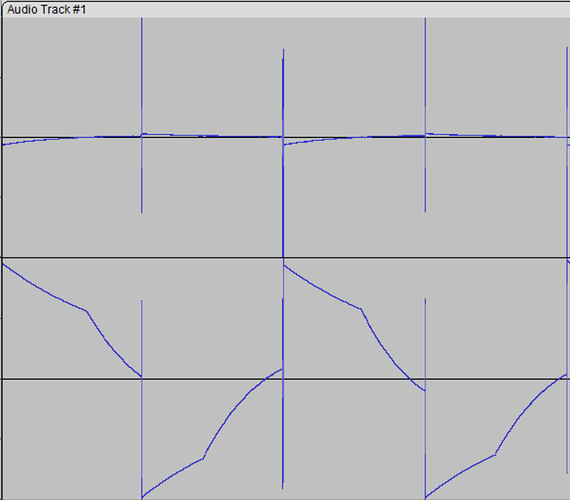@Bob, I played the M1 Omni-8 signal into my computer and recorded it in Audacity open source software because I’d like to use the signal as an input to my Sentient Element PEMF device. Is this what the waveform is supposed to look like?
Hi Brian, unfortunately an approach like that can never work because audio signals are limited by audio amplifiers and audio filters to only work in a certain range of frequency components in the 20-20kHz range, optimized for voice and music. As a result, the waveforms you have recorded are not the waveforms actually being generated by an ICES-PEMF system. They are filtered and distorted as the computer tries to extract only the audio information from the signal.
All computers, smart phones, and audio systems in general will have this hard limitation. So the waveforms you have recorded are not going to work to elicit a biological effect in the same way PEMF does, because biologically effective PEMF operates in an entirely different range of constituent frequencies.
By this I do not mean the simple carrier frequencies such as “10 Hz”, what I mean, and what is important, and what no audio system can ever do, is capture the actual shape of a biologically-active ICES-PEMF waveform.
This is why there is no such thing as DIY PEMF using smart phones that actually works and has a biological effect. It can never work that way, sorry.
To get it to work properly, you need a tuned system that generates waveforms of the correct shape, and that requires electronic hardware that is entirely different than the hardware in any audio system, but that is exactly the hardware I have designed and built into ICES-PEMF.
Thank you, Bob.
To summarize your explanation:
Computers, cell phones and other audio systems cannot reproduce the shape of the ICES-PEMF waveform because:
- The audio components are optimized for voice and music, and
- There are characteristics of the ICES-PEMF waveform that fall outside this optimization.
Knowing this, is there a way to make using the Sentient Element effective?
Thank you,
Brian
I believe your summary is accurate. It is a hardware limitation of all audio systems.
Are you asking me to describe a way to make the Sentient Element (PEMF) product more effective? My understanding is that it is just another high power (because of very low efficiency waveform shape) PEMF system. I could be wrong; that is just my impression. This is usually because, once again, most PEMF systems have their waveforms wrong (not properly shaped to elicit biological effects), so they need to crank up the power just to get it to work, sometimes, sort-of.
If that is the case with their products, then, the only way to fix that problem is to redesign the output stage electronics of the pulse generator and coils to tune them to get the waveform shape correct… once again, a hardware change would be necessary.
But that system might be over-powered enough to get some beneficial effects, I am just not sure.
Thank you. I hope I can get some benefit from the Sentient Element.
I read somewhere on the forum that you are working on an ICES bed for treating larger areas of the body. Is that true?
Yes, indeed I am. I am testing a pad with a larger array of coils right now. Technically, it is quite difficult to get a large area with the correct waveform shape. But I am definitely making progress.
That will be awesome.
i had considered saving my pennies for a mattress system by another manufacturer… but heck, I’ll definitely be looking to wait to get your version! the c5 has been beneficial to my parents. a lil mattress would be great. when i compare the single port a9 to the effect i feel from the 4 port,i can’t dispute there’s a notable difference! my parents even from a difference from “more is better” in this format.
I want one too. Will you be using the C5 with that, or will there be a new device to power the new mat?
My assumption may be wrong, but my thought to your question is that given the C5 is for the most part 4 M1s synchronized and enclosed in a case, I assume that a larger array of coils that covers a larger area with the correct waveform shape involves creating a new product that is not the same as his C5 product.
That is basically correct. The challenge is that the output waveform needs to be correct across the entire pad. With larger coils, you lose too much intensity across the coil face and it only works around the edges (people who buy PEMF systems with huge “whole-body” coils, beware!), so it really only works with an array of many smaller coils. When you build a large array of smaller coils, they tend to interact electronically and cause ringing and distortion of the waveform produced by each coil, even when you try to drive them exactly the same way (synchronized timing within 1 micro-second). So, it requires a different pulse generator design. You can’t just add up a bunch of C5’s, unfortunately.
So you have to be able to monitor the waveforms real-time. How do you do that… through the air or through the wires?
You do not have to monitor them in real time. You have to start by making a PEMF system that is correctly tuned to generate the correct waveforms. Once it is properly tuned, then it can run without constant monitoring.
It’s just like a piano: tune it properly, then it will sound right, and you do not need to check every sound wave that it makes. Real pianos eventually go out of tune, but a digital device such as ICES-PEMF will remain correctly tuned so long as you do not modify them beyond the limits for which they are designed.
